The Pinakothek der Moderne, Munich, houses four museums: the Modern Art Collection of the Bavarian State Painting Collections, the Staatliche Graphische Sammlung München, the Architekturmuseum der TU München and Die Neue Sammlung – The Design Museum. A quartet whose collections for all that they are separate, autonomous, aren't independent of one another, rather they intersect, support and contradict one another and thereby exist in context of one another.
With 4 Museums – 1 Modernism that 1 Pinakothek der Moderne, Munich, pools the 4 collections it houses for an exploration of the rise and development of Modernism in the earliest decades of the 20th century.......

As much as being a presentation based on 4 collections, 4 Museums – 1 Modernism is also an exhibition in 4 chapters; 4 chapters staged in a cube that you can approach clockwise or anti-clockwise. Or ideally both: go one way, then the other, then back again, and back again, ad nauseam, ad infinitum. That multi-directional viewing you weren't allowed to do during the Covid years, but that is essential in viewing any exhibition.
For our part we'll discuss 4 Museums – 1 Modernism as traversed anti-clockwise starting with the chapter New Aesthetics which introduces the likes of, for example, a Bruno Paul, that, let's say, older practitioner, who was so influential for a generation of younger creatives in the first decades of the 20th century, and whose ca. 1929 bookcase helps elucidate how the formal expressions of the late 19th century found their way into, and their transformation in context of, the formal expressions of the early 20th; a J. J. P. Oud that so regularly, and unfairly, overlooked Dutch Modernist, who is represented by a variety of works including a 1933 steel tube armchair that hovers on the border between genius and mania, but which for all reminds of the complexity of the (hi)story of steel tube furniture that is absent from the contemporary narrative of the (hi)story of steel tube furniture.
Or a Peter Birkenholz whose 1927 proposal for a Kugelhaus, essentially a ball-shaped construction, as a hotel in Leipzig, and whose realisation in 1928 of a Kugelhaus as an exhibtion hall in Dresden, tend to confirm the impression given by Shape of Dreams. The Architecture of Witold Lipiński at the Muzeum Architektury, Wrocław, that while the house of the future is always round, see not just a Lipiński but also, for example, an Arne Jacobsen/Flemming Lassen, a Richard Buckminster "Bucky" Fuller, or the Futuro House by Matti Suuronen that stands in front of the Pinakothek der Moderne, and while the house of the past as represented by innumerable global cultures and communities is round, the house of the now is as quadratic as the exhibition space you find yourself in.
How did that happen? How did the future not happen?
¿Because of the Modernists with whom you currently share a quadratic space?
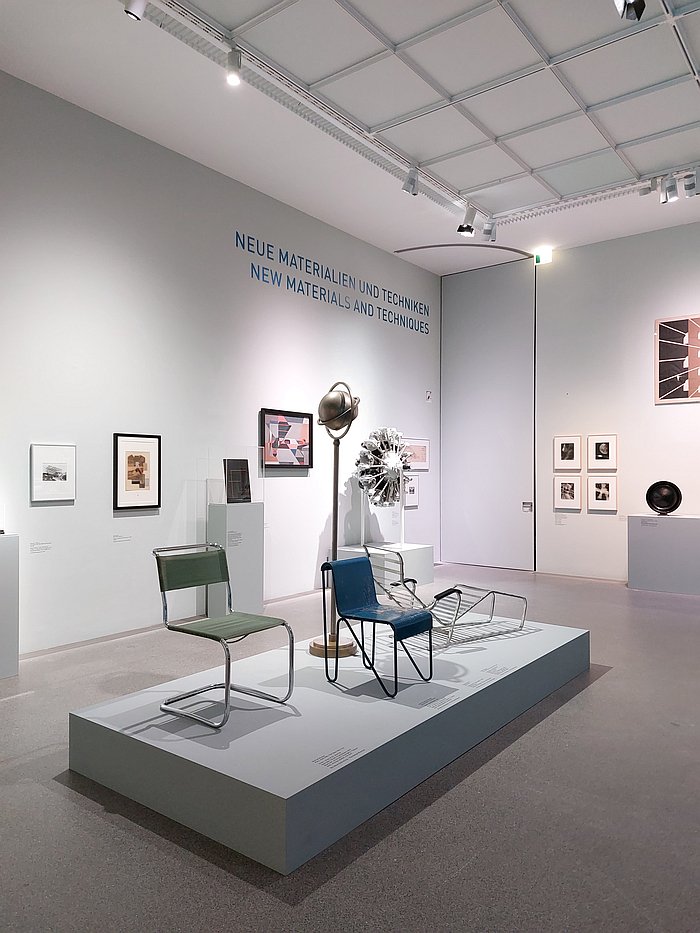
As oft noted in these dispatches, an important aspect, arguably, the key, to the new aesthetics of 4 Museums – 1 Modernism's chapter is and was the development of novel materials and novel processes, an argument tending to be reinforced by the chapter New Materials and Techniques with its presentation of, for example, a 1929 table lamp by Christian Dell for Stotz-Kontakt crafted from Bakelite, that important early synthetic plastic and a lamp that is a component of our claim that Dell was the world's first Plasticsmith; or a Pratt & Whitney R-985 Wasp Junior aircraft engine from 1928 as a reminder of the rise, rise and rise of air travel in the early 20th century and its influence on society and creativity; or the anonymous vacuum cleaner from ca. 1930 that stands proxy for the rise of electronic household goods in the early 20th century, and which in being modelled on a field canon - no honest! - reminds that in Europe war is never far away. That in Europe war is as real a possibility in 2030 as it was in 1930.
In which context, both war and the rise of electronic household goods in the early 20th century, New Materials and Techniques also includes an example of Walter Maria Kersting's 1933 Volksempfänger radio, that object that, as oft discussed in these dispatches, not least from Design of the Third Reich at Design Museum Den Bosch, ‘s-Hertogenbosch, and From Luther to Twitter. Media and the Public Sphere at the Deutsches Historisches Museum, Berlin, represents the NSDAP's use, abuse, of both new technology and the new aesthetics of a Modernism they claimed to be an alternative to, a negation of, to help them transport their poisonous propaganda directly into every home, and that was such an important tool of the NSDAP. Thankfully we've moved on from such horrors. Both the spreading of poisonous propaganda via carefully designed contemporary electronic products/technology, and from toxic political doublethink. 🙄
And a chapter on New Materials and Techniques in the course of which one regularly meets Bauhäusler, including, for example, Marcel Breuer, Paul Klee, T. Lux Feininger, Lászlo Moholy-Nagy or the aforementioned Christian Dell. A regularity that thus neatly sets up the chapter New Institutions with its reflections on, and discussion on the relevance of, not just Bauhaus, but also Burg Giebichenstein Halle and on the novel architecture of the period as advanced by the likes of, for example, Richard Riemerschmid or Robert Vorhoelzer, including the latter's Postamt on Munich's Goetheplatz, an important reminder amongst all the invented tradition of contemporary Bavaria that Bavarians not only influenced the rise and development of Modernism but that Modernism also influenced Bavaria. Even if a lot has been forgotten/sacrificed since. Before 4 Museums – 1 Modernism ends, if you follow the presentation anti-clockwise, starts if you follow it clockwise, with New Society, a chapter whose effortless integration with the other three chapters helps elucidate and reinforce the interplay between creativity and society, that ongoing two-way influence of creativity on society and of society on creativity. That the one simply cannot exist without the other.
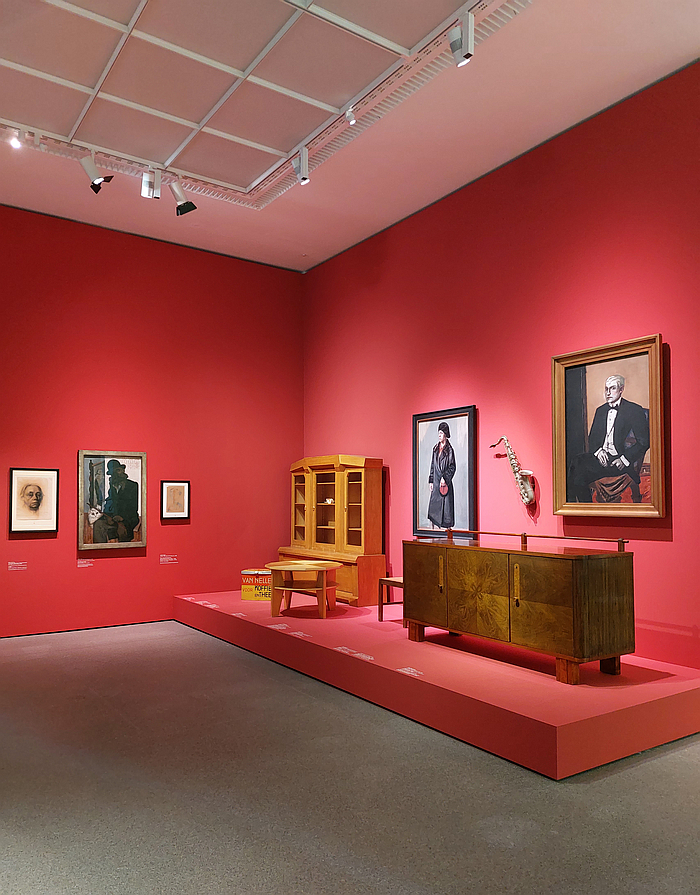
A New Society represented in 4 Museums – 1 Modernism via works such as, for example, a so-called Skyscraper bookcase by Paul Theodore Frankl from 1928, from 1928 New York to be precise, a chair from Adolf Scheck's 1926 Billige Wohnung, Cheap Apartment, furniture programme, a coffee and tea caddy by Jacob Jongert for Van Nelle. Or a 1920s saxophone by Brussels based instrument maker F. Buyst. And thus an example of that instrument which, as noted from Play, Life, Illusion. Xanti Schawinsky at Kunsthalle Bielefeld, was still relatively new, and very dangerous, in the first decades of the 20th century, that instrument which in many regards symbolised, and still symbolises, the new society of the age; and an instrument that came close to being banned in Germany in 1933 by the NSDAP in act of both outright racism and spiteful opposition to the novel society the NSDAP were opposed to.
And a Xanti Schawinsky who features in 4 Museums – 1 Modernism via the Studio 42 typewriter he co-designed for Olivetti in 1935 during his brief stay in Italy having fled the Hitler dictatorship, and before he fled the Mussolini dictatorship for America. A typewriter that is very easy to place in a process of ongoing physical and formal reduction of Olivetti's typewriters, and also in Olivetti's (hi)story of employing creatives of various hues to shape their industrial products; and a commercial typewriter that standing, as it does, so diametrically juxtaposed to the experimental work Schawinsky produced before his enforced time in Italy, most notably at Bauhaus Dessau, that allows one to reflect on the 1 Modernism of the title.
Allows one to question the 1 Modernism of the title.
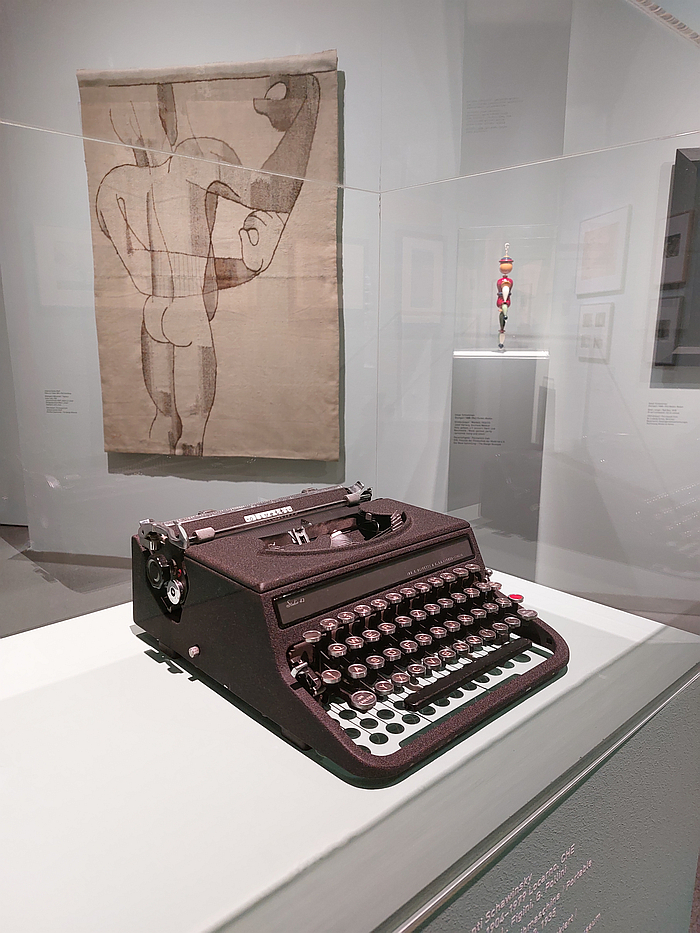
A questioning of the 1 Modernism of the title that accompanies you throughout the presentation with its variety, contrast, heterogeneity.
Is, for example, Paul Theodore Frankl's Skyscraper bookcase the same Modernism as Bruno Paul's housing estate-esque bookcase? Is Marcel Breuer's B33 steel tube cantilever the same Modernism as Gerrit T. Rietveld's Beugel steel tube chair? Is Peter Birkenholz's Kugelhaus the same Modernism as Le Corbusier's quadratic house for the Weissenhof Siedlung, Stuttgart? Is the saxophone the same Modernism as the Volksempfänger?
¿Is/was there really only 1 Modernism?
If there is we didn't see it in the Pinakothek der Moderne.
We did however see numerous approaches at finding, defining and garnering support for, a way to respond to a world in flux. Did see a variety of propositions, positions and paths that sought to help society move on in context of the ongoing consequences of the rapid rise of industrialisation in the late 19th century, the increasing reliance on machines, automobiles, technology of the early 20th century with the problems and advantages such brought, and the horrors, deprivations and social and demographic challenges of the War of 1914-1918, that War to end War.
Did see 4 Museums – >1 Modernism.
A variety of paths through the 1920s and early 1930s that very much echoes the number of paths taken through the 1970s and 80s as discussed by and from Everything at Once: Postmodernity, 1967–1992 at the Bundeskunsthalle, Bonn, that caused us to reject the term 'Postmodern'. And that also tends to reinforce the numerous paths we've taken since then to today, to our 1 Today with its myriad divergent realities. And by extrapolation tending to contradict, negate, our regular search for the path forward from our 1 today. Makes clear that that one path doesn't exist. It will be numerous paths.
And also makes clear that that is fine. Or perhaps more accurately, 4 Museums – 1 Modernism makes clear that it doesn't matter how many paths there are as long as there is dialogue between the differing paths, as long as the differing paths exist in open, constructive discourse with one another. A dialogue and discourse that can very much be felt in 4 Museums – 1 Modernism, a communication between the various paths, between the diverse protagonists, between the myriad Modernisms, that is very much present, arguably ongoing, in 4 Museums – 1 Modernism. And which you're very much invited to join. Dialogue, discourse and communication between positions and propositions that for all their differences are unified by a desire to move forward that is very much present in 4 Museums – 1 Modernism.
Or 4 Museums – 1 Compass.
Dialogue, discourse and communication that we're increasingly not undertaking, individually and collectively, preferring instead to aggressively insist on the validity of our propositions, positions and paths and to denounce out-of-hand as worthless and dangerous the propositions, positions and paths of all others. With all the foreseeable problems that will bring with it. Has brought with it.
4 Museums – 1 Modernism is a reminder that it can be different.
And also an admonishment that there are lessons to be gleaned from the paths thus taken.
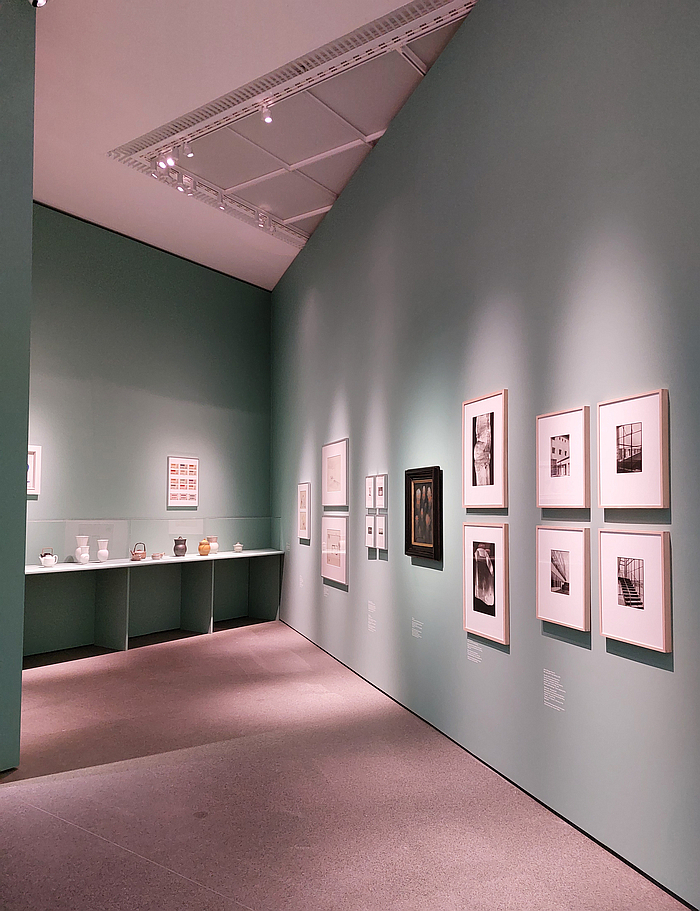
For all that 4 Museums – 1 Modernism is an exhibition primarily based in the, then, Germany of the early 20th century, the selection of protagonists helps elucidate how international not only that Germany was but how international the rise and development of Modernism was: in the course of the presentation one meets, for example, Ukrainians, Russians, Poles, Dutch, Americans, even a few Germans. And the occasional Bavarian.
Viewing the presentation we were very much reminded of the complaint by Mathilde von Freytag-Loringhoven, that long-term bane and opponent of Bauhaus Weimar, and the new aesthetic and new society they sought, concerning the number of foreign students at the Weimar Bauhaus, "primarily Austrians or Hungarians, even, they say, a Russian".1 Yes, there was at least one Russian, and several Austrians and Hungarians, at the Weimar Bauhaus. And also Belgians, Swiss, Americans. Who later on in Dessau were joined by Japanese, Indians, Brits, etc, etc. And not just at the Bauhauses but on the numerous paths through the 1920s and 30s one meets protagonists and creatives from a wide spectrum of nations.
Fortuitously. For as 4 Museums – 1 Modernism tends to underscore, tends to imply, a lesson we needs must learn in the 2020s and 2030s, is that you can't develop a new society, far less a new aesthetic, on the basis of a perceived national identity. Certainly not on the basis of a retrotopian national identity.
Nor on the basis of a practised patriarchalism.
Despite what 4 Museums – 1 Modernism implies.
Or put another way, and as the more astute readers will have appreciated from the creatives thus far named, 4 Museums – 1 Modernism for all that it is very international, is very much a male-centric presentation.
You have to search long and hard to find female Modernists in 4 Museums – 1 Modernism.
And when you do they are invariably represented via textiles or ceramics; it's all very reminiscent of the role women were expected to accept at the Weimar and Dessau Bauhauses. Unless we missed it, which we don't believe we did, there isn't and wasn't a single piece of furniture or an architectural project credited to a female. And certainly no technical machinery. Yes, there are a couple of photos by Florence Henri and Lucia Moholy, but not only are they few in number in comparison to the photos by men, but, as we all recall from Moderne am Main 1919-1933 at the Museum Angewandte Kunst Frankfurt, in the 1920s photography became something it was acceptable for females to do. Something men let females practice. And Walter Gropius arguably never respected Lucia Moholy as a photographer, while being more than happy to employ her photos uncredited to promote the Bauhauses and himself.
Thus as a presentation 4 Museums – 1 Modernism tends to an argument that Modernism was initiated and developed by men. Which while not entirely incorrect, see, for example, an Eileen Gray's arguments about Le Corbusier representing an architecture of the patriarchy, a position she actively challenged, it isn't entirely correct.
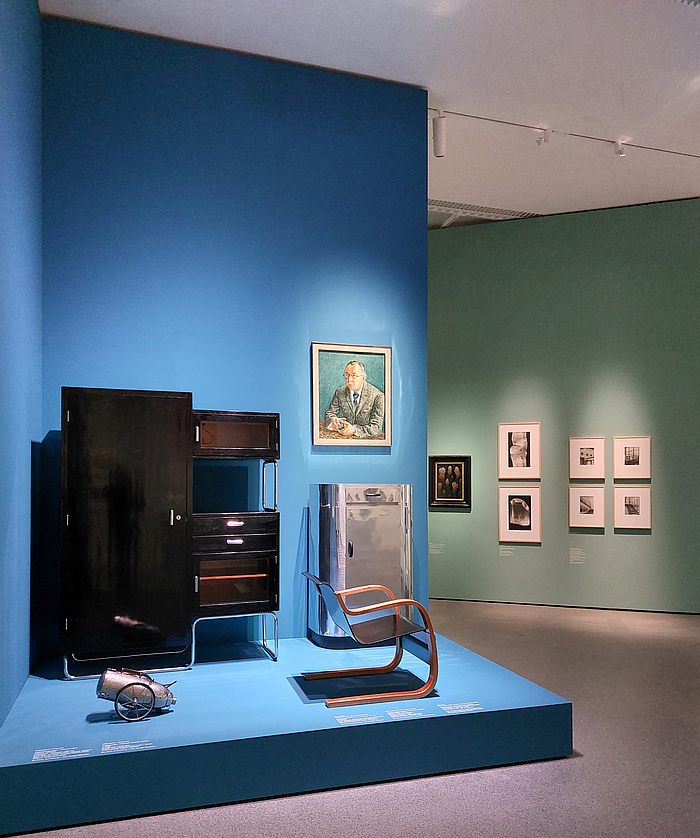
An argument, given that it is constructed via objects taken 100% from the collections of the four museums housed in the Pinakothek der Moderne, that enables considerations on the skewing that occurs when museum collections contain biases and restricted views. A point discussed at length in these dispatches from Regard! Art and Design by Women 1880–1940 at the Bröhan Museum, Berlin, a Berlin State Museum for Art Nouveau, Art Deco and Functionalism whose collection, as one learned from Regard!, contains nothing by Berlin's very own Lilly Reich. Despite the number of Art Nouveau, Art Deco and Functionalism years Reich was active in the city. And the contributions to Art Nouveau, Art Deco and Functionalism she made in the city. We don't know if any of the Pinakothek der Moderne's four museums possess any works by Lilly Reich, but there are none on show in 4 Museums – 1 Modernism; there is however a work by Ludwig Mies van der Rohe, that shadow which so obscures Reich. Certainly since the Museum of Modern Art, MoMA, New York, initiated the process of writing Reich out of architecture and design (hi)story. Nor do we know if they have any works by Marianne Brandt, there are certainly none on show, but a lamp by her colleague in the Bauhaus Weimar Metal Workshop Wilhelm Wagenfeld is deemed worthy of exhibiting. We do know that Die Neue Sammlung – The Design Museum have a 1930s chair by Eileen Gray, that isn't on show in 4 Museums – 1 Modernism2, while the architecture of Le Corbusier is. And there is a strong argument to be made that the Alvar Aalto Armchair No. 31 on show is actually an Armchair No. 31 by Alvar and Aino Aalto. Or Aino and Alvar Aalto as the pair were known before, again, the Museum of Modern Art, MoMA, New York, who have a long (hi)story of such, thought better and wrote Aino out of the partnership. To name but four examples. There are others that can be named.
While the 1926 painting Tennisspielerin by Anton Räderscheidt tends to expand Guerilla Girls' position that women need to be naked to get into museums to women need to be naked to get into exhibitions exploring the rise and development of Modernism.
Thus, as much as being a presentation that explores the rise and development of Modernism, 4 Museums – 1 Modernism is also very much an admonishment to not only reflect more closely on what is contained within any given museum's collection, the narrative of creative (hi)story that collection tells, the probability of the narrative told, and thus an admonishment to reflect on how any given museum collects today, to question the presence of skews, biases, personal preferences, groupthink, in the contemporary collection approach, for that which is collected today is the basis for the narrative told tomorrow. But also an admonishment to question how any museum, specifically the four museums housed in the Pinakothek der Moderne, use their collections, how they approach their collections, when choosing objects for exhibitions.
Why is 4 Museums – 1 Modernism, 4 Museums – 1 Gender?
How did 4 Museums – 1 Modernism end up so male?
Was it so in the 1920s and 30s? Were all the important furniture and architecture projects, all the enduring and influential furniture and architecture projects, by men and all the important, enduring, influential ceramic and textile projects by females? Really? Is 4 Museums – 1 Modernism an accurate image of the period under investigation? Or are there structural problems in how the memories of creativity in the first decades of the 20th century were formed and have subsequently been maintained? Much as Fairy Tale. Childhood in Lithuania during the late Soviet era at Kaunas Picture Gallery questioned the forming, maintenance and reliability of memory, collective and individual, in context of childhood, how reliable is our collective memory of the first decades of the 20th century as expressed in museum collections?
Why is the house of the past round, the house of the future round, the house of the now quadratic?
¿Because of Modernists, or because of how the complexities of Modernism are organised, mediated, discussed, utilised, extrapolated today? ¿Because of how the complexities of Modernism are remembered?
¿The reduction of years, decades, of discourse, dialogue and disagreement down to 1 Geometry?
¿The reduction of years, decades, of discourse, dialogue and disagreement down to 1 Modernism?
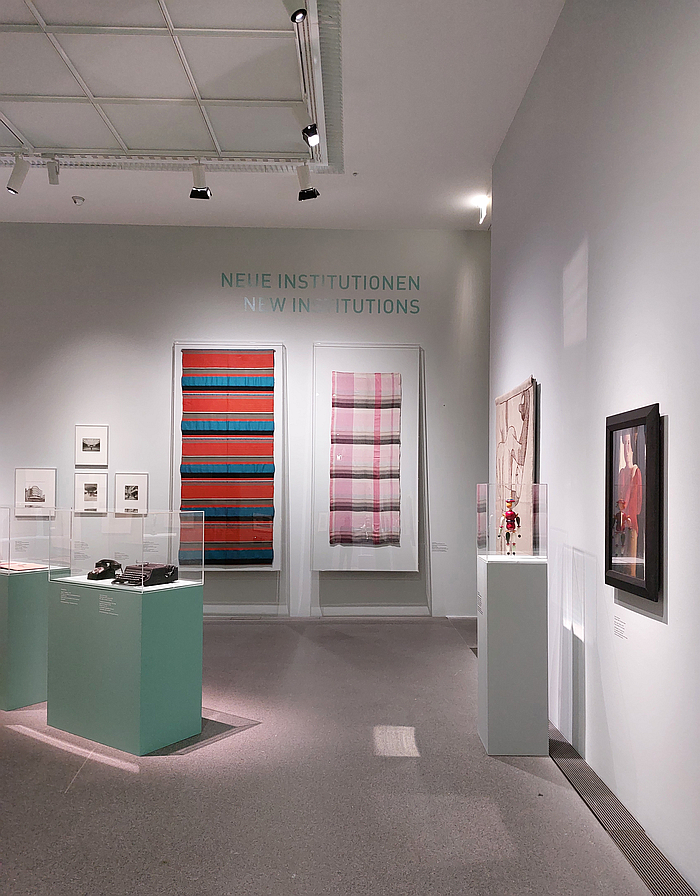
While the male-centric presentation is a real issue, is something you should very much be aware of, should actively question, while viewing 4 Museums – 1 Modernism, if you are, and if you do, it doesn't detract from an exhibition that provides for a very nice, succinct but not hurried, overview of not only the myriad responses to the challenges of the period, but also, arguably primarily, of the interplay between creative genres in the development of those responses, of the dependency of art, architecture, craft and design on one another in approaching responses. And also of the manner in which technology influences creativity and society: the Pratt & Whitney engine may appear an odd choice amongst all the furniture, ceramics and art, but, and as with the saxophone, helps one approach the other exhibits from differentiated perspectives, and thereby to better approach the rise and development of Modernism from more perspectives than one is normally enabled, empowered, to. If, yes, with the tacit accepted dominance of the Y-chromosome.
A presentation that, as noted above, also underscores the interplay between creativity and society, a relationship in which neither has the lead, or perhaps more accurately neither has a natural lead, there is naturally an equilibrium at work, an equilibrium political forces regularly seek to disrupt. Did seek to disrupt, arguably did disrupt, in the period under discussion. And are seeking to disrupt in our age. And that thereby underscores the very easy comparison that can be made between the first third of the 20th century and the first third of the 21st century, that way (hi)story doesn't repeat itself but does return to similar locations in differing contexts, thereby enabling us to learn. If we're wise enough to. Helps underscore that we have our new institutions, new materials, new technologies just as our forbearers did, where will they take us in terms of aesthetics and society? How will the dialogue between the past and the now lead us into the future? What shape will our houses take in a near-future Europe? What place will the saxophone take in a near-future Europe?
A presentation in which the fluid, invisible, transition from one chapter to the other stands proxy for the manner in which the various epochs into which we subdivide the (hi)story of creativity transition fluidly, invisibly, from one to the other: Where did Modernism begin? Where does it end? Does it end? ¿Can it end? Did anything end when Modernism began? Thereby helping underscore the fallacy of pigeon-holing creativity into epochs, a process invariably undertaken for academic convenience, to enable the production of coffee table books, or from a popular blithe unquestioning acceptance of the conventions of the past. And which we need to move on from, we need to stop seeking to compartmentalise that which is continuos, much as with his glissandos a Iannis Xenakis stopped compartmentalising tone, and start concentrating on the contexts, on the positions, on the motivations, on the society in which the respective object is and was intended to find its function, on the object's function in society, on relationships.
And for all we need to start appreciating the (hi)story of creativity, the (hi)story of society, as an ongoing augmentative, accumulative, inter-twined, process, not a neatly definable successions in separate, autonomous genres. Which, yes, does bring us back to the 1 Modernism of the title. And the 4 Museums of the title.
And thus for all the incongruities of the title, and maleness of it presentation, 4 Museums – 1 Modernism not only allows for more nuanced insights into the rise and development of that which is popularly known as Modernism, but for all into the importance of approaching the past from a multitude of perspectives; why understanding any aspect of (hi)story, any (hi)story, can never be undertaken from just one perspective, rather one must view it as the interchange and interplay between the myriad influences it is.
A myriad influences 4 Museums – 1 Modernism makes a convincing argument progression forward needs must always be based upon.......
4 Museums – 1 Modernism is scheduled to run at the Pinakothek der Moderne, Barer Straße 40, 80333 Munich until Sunday September 28th.
Full details can be found at www.pinakothek-der-moderne.de
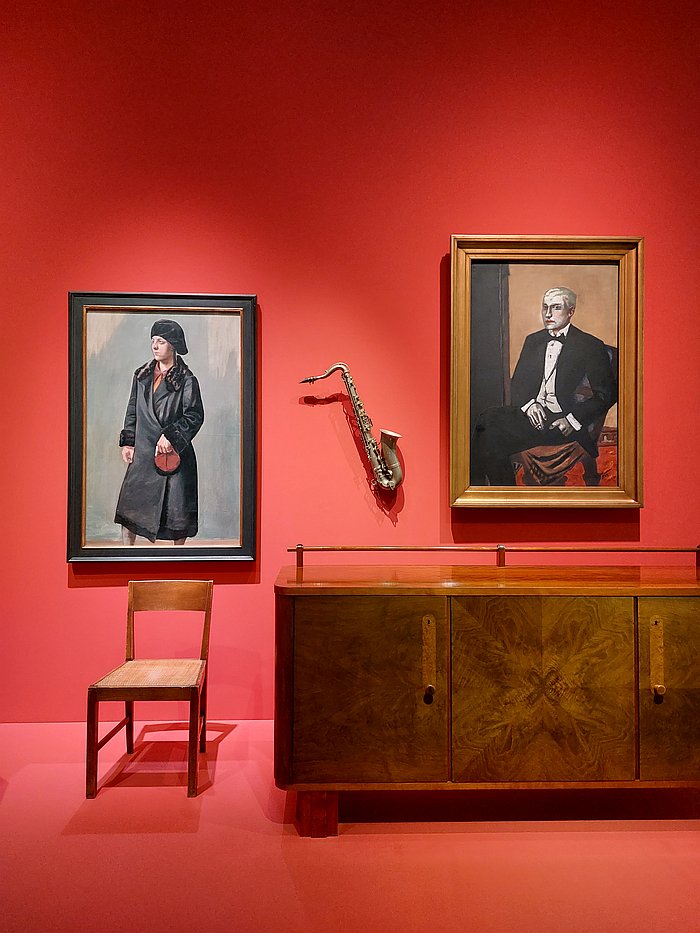

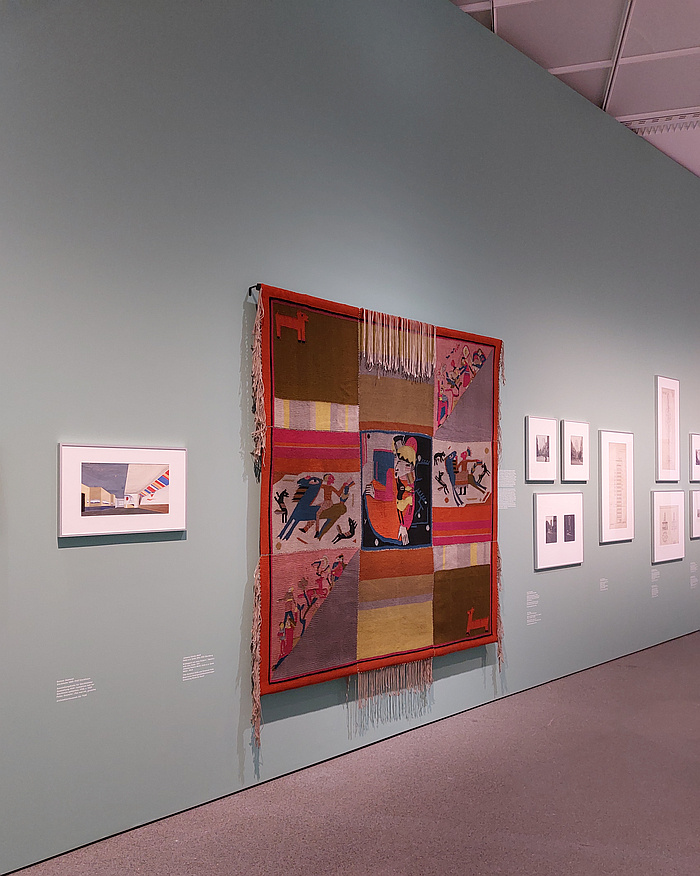
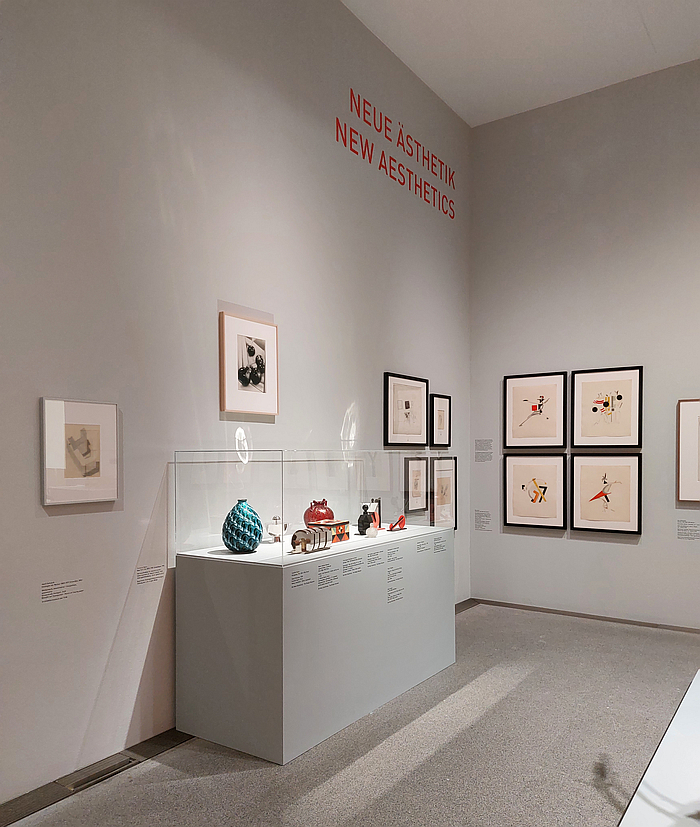
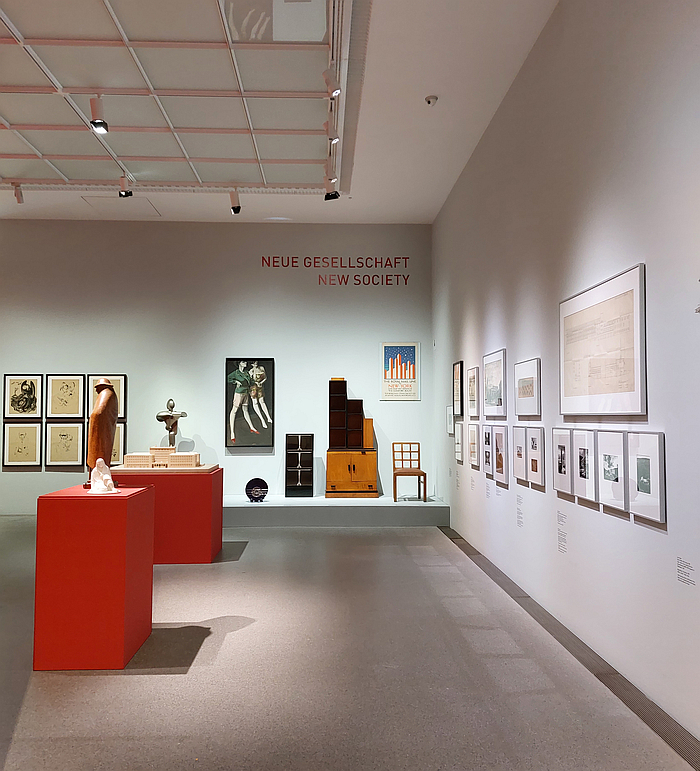
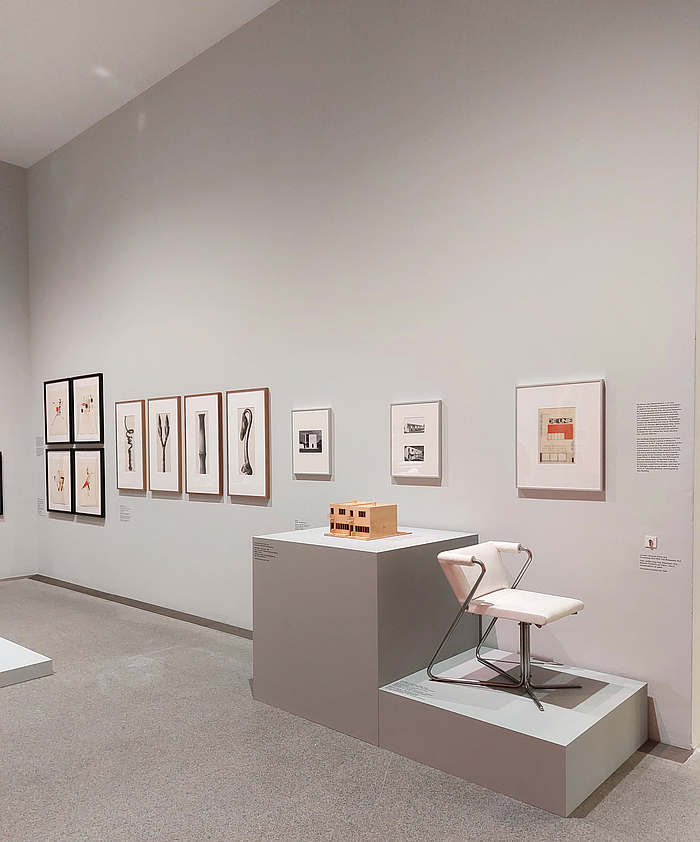
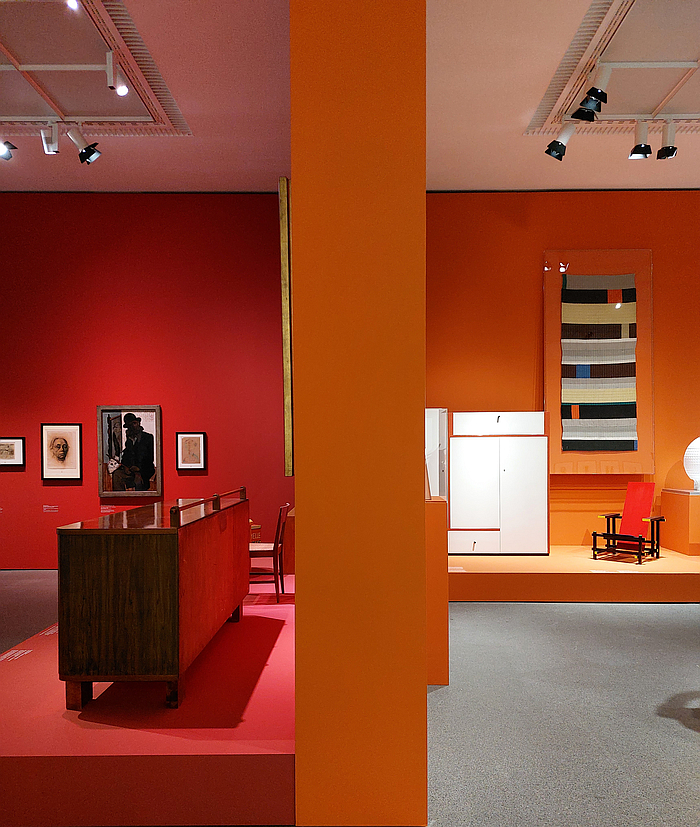
1Mathilde von Freytag-Loringhoven, quoted in Volker Wahl (Ed), Das Staatliche Bauhaus in Weimar. Dokumente zur Geschichte des Instituts 1919–1926, Document Nr 226 Pressebericht über die am 19. Dezember 1919 stattgefundene Sitzung des Gemeinderats von Weimar in der Weimasrichen Landeszeitung Deutschland von 20. Dezember 1919 (Auszug), Böhlau Verlag, 2009
2In the interests of fairness (and completion) Eileen Gray' S-Chair is scheduled to be part of the new permanent collection presentation 100 Years - 100 Objects in Die Neue Sammlung – The Design Museum, part of the celebrations to the 100th anniversary of the grounding of Die Neue Sammlung – The Design Museum. However, is the whole point of permanent collection exhibitions not to lend things to temporary exhibitions? And where would the S-Chair have more significance over the summer of 2025? And is there not a need to continually reshape permanent collection exhibitions, regularly change the objects on show, to prevent the presentation becoming monosyllabic: could the S-Chair not be added in the autumn in place of another object? 100 Years - 100 Objects is scheduled to open on May 22nd 2025. And, yes, you're right, we're also very curious to see the numbers, we'll be sure to let yous know.......